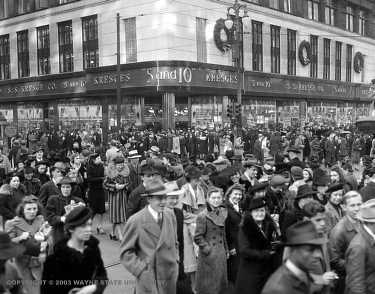Wanted: A desperate willingness to experiment

S.S. Kresge on Woodward Avenue, Detroit, 1934. At its peak, Detroit had a population of about 2 million people.
I haven't read the front section yet, but I saw this article, "With Detroit in dire straits, mayor invites big thinking" in the Post.
It's the difference between Baltimore and Pittsburgh say vs. DC. DC isn't all that innovative and has a weak civil society sector. But it has a strong real estate market because of the relative stability of the federal government as a jobs generator, so it doesn't have to be all that innovative.
Working on neighborhood revitalization in the early part of the last decade in the H Street neighborhood wasn't that easy. Few people wanted to buy houses in the neighborhood. Retailers were leaving the corridor. Independent retailers were mostly marginal businesses. There was a lot of disorder--vagrancy, drug dealing, nuisance properties, etc.
And yet we were a few blocks from Union Station, less than one mile to the U.S. Capitol, less than two miles to the heart of Downtown, with a residential building stock not unlike the Capitol Hill neighborhood a few blocks to the south, where houses were worth triple, quadruple, and quintuple the value of the same type of houses in my neighborhood, plus the history of the neighborhood too, in the context of a strong real estate market in the region, if not the city.
But just think how much harder it is to work on revitalization in places like Flint, Michigan, Youngstown, Ohio, or Baltimore, Pittsburgh, Philadelphia, or St. Louis, not to mention Detroit--after Katrina on a tour, dealing with the outrage expressed by a resident, I couldn't help but blurt out that it didn't look all that different from Detroit, even though the decline of Detroit was a longer process (then again, so was the decline of New Orleans).

And so I used to think long and hard about how I would go about working on neighborhood revitalization in places with weak real estate markets, places like Baltimore or Detroit.
It might be that Detroit's only long term saving grace other than some residual industriousness and industry and incredible commercial building stock (which is the foundation of urban revitalization strategies everywhere) is proximity to fresh water, in a country where supplies of fresh water are likely to diminish in concert with global warming.
Detroit is the endgame of how the automobile industry intended for cities to leach out, in favor of suburban metropolises organized around automobile-based transportation. The Detroit "metropolitan" area is the most exurbanized region in the U.S.

Spread on ideal highway construction, Fortune Magazine, August 1936.



0 Comments:
Post a Comment
<< Home